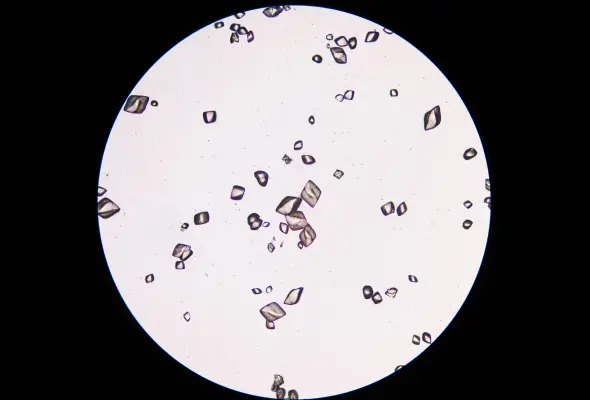-
Doctors
-
Specialities & Treatments
Centre of Excellence
Specialties
Treatments and Procedures
Hospitals & Directions HyderabadCARE Hospitals, Banjara Hills CARE Outpatient Centre, Banjara Hills CARE Hospitals, HITEC City CARE Hospitals, Nampally Gurunanak CARE Hospitals, Musheerabad CARE Hospitals Outpatient Centre, HITEC City CARE Hospitals, Malakpet
HyderabadCARE Hospitals, Banjara Hills CARE Outpatient Centre, Banjara Hills CARE Hospitals, HITEC City CARE Hospitals, Nampally Gurunanak CARE Hospitals, Musheerabad CARE Hospitals Outpatient Centre, HITEC City CARE Hospitals, Malakpet Raipur
Raipur
 Bhubaneswar
Bhubaneswar Visakhapatnam
Visakhapatnam
 Nagpur
Nagpur
 Indore
Indore
 Chh. Sambhajinagar
Chh. SambhajinagarClinics & Medical Centers
Book an AppointmentContact Us
Online Lab Reports
Book an Appointment
Consult Super-Specialist Doctors at CARE Hospitals

Crystals in Urine
Symptom, Causes, Diagnosis and Treatment
Crystals in Urine
Have you ever noticed tiny particles floating in your urine? These mysterious specks might be crystals in the urine, a common occurrence that can sometimes signal underlying health issues. While often harmless, understanding the causes and types of these crystals can provide valuable insights into your overall well-being. From uric crystals in urine to various other forms, these microscopic structures can appear due to different factors in the body.
We'll explore the risk factors that increase the likelihood of crystal formation, discuss possible complications, and outline diagnostic methods.

What are Crystals in Urine?
Crystals in urine, also known as crystalluria, occur when there is an excessive concentration of minerals in the urine and insufficient liquid. These abnormal crystals in urine can collect and form masses, which may be detected during a urinalysis.
Types of Crystals in Urine
Several types of crystals can form in urine, each with distinct characteristics, such as:
- Calcium oxalate crystals are the most common, comprising up to 80% of all kidney stone cases. These crystals can appear due to high oxalate diets or certain medical conditions.
- Calcium phosphate crystals represent about 10% to 20% of kidney stones and may indicate conditions causing hypercalciuria or alkaline urine formation.
- Struvite crystals of ammonium, magnesium, and calcium phosphate are often associated with urinary tract infections.
- Uric acid crystals in urine typically form in acidic conditions and can be linked to gout or excess protein intake.
- Cystine crystals, appearing as hexagonal plates, are rare. They may occur in people with cystinuria, a genetic disorder.
Symptoms of Crystals in the Urine
Crystals in urine may not always cause noticeable symptoms, especially when small. However, larger crystals or those that form stones can lead to various uncomfortable signs. These include:
- Sharp pains in the lower abdomen, side, groin, or back
- Frequent urges to urinate
- Difficulty passing urine
- A burning sensation during urination
- Blood in the urine
- Cloudy or foul-smelling urine
- Nausea and vomiting
- In some cases, people might develop a fever, particularly if the crystals have caused an infection.
Causes of Crystals in Urine
Crystals in urine form when there is an excessive concentration of minerals in the urinary system. This can be due to:
- Dehydration, which reduces the liquid content in urine
- A high-protein diet or diet containing excessive salt can also contribute to crystal formation.
- Certain metabolic issues affect the balance of minerals and substances that prevent crystallisation.
- The acidity level of urine plays a role in crystal development, with different types forming in acidic or alkaline conditions.
Risk Factors
Several factors increase the likelihood of developing crystals in urine, such as:
- Dietary habits, such as high protein or salt consumption, contribute to crystal formation.
- Certain medical conditions, including renal tubular acidosis and hyperparathyroidism, raise the risk.
- Obesity and large waist size have been linked to an increased chance of developing urinary crystals.
- Some medications, like calcium-based antacids and certain migraine treatments, can also lead to crystalluria.
- Family history is another important factor, as individuals with relatives who have experienced kidney stones are more prone to developing uric crystals in urine.
- Digestive diseases and surgeries that affect mineral absorption can form abnormal crystals in urine.
Complications
Untreated stones may result in blockage of the ureter, causing damage to the kidneys and bladder. This obstruction can lead to kidney infections and urinary tract infections (UTIs).
In some cases, the presence of crystals might indicate underlying metabolic problems or genetic conditions like cystinuria.
Diagnosis for Crystals in Urine
Diagnosing crystals in urine typically begins with a urinalysis. This investigation involves providing a urine sample, which is then examined for colour, cloudiness, and other visible signs. A lab technician uses a dipstick to test for various components and examines the sample under a microscope to identify any crystals present.
Doctors may recommend additional tests based on the findings, such as:
- Blood work to evaluate liver functions and various parameters
- Ultrasound might be necessary to evaluate liver health if bilirubin is detected.
- A 24-hour urine collection to assess parameters such as urinary volume, pH, and mineral levels
Treatment of Crystals in Urine
The treatment modality for crystals in urine depends on the cause and type of crystals present, including:
- Hydration: Increasing fluid intake, particularly water, is often the first step to managing crystalluria & preventing complications.
- Dietary Changes: Doctors recommend dietary modifications based on the nature of crystals. For example, individuals with calcium oxalate stones might need to limit oxalate-rich foods.
- Medications: Doctors will prescribe medicines to prevent crystal formation or treat underlying conditions. These may include thiazide diuretics for hypercalciuria or allopurinol for uric crystal in urine.
When to See a Doctor
While crystals in urine don't always require medical attention, certain symptoms warrant a doctor's visit, such as:
- Sharp pains in the lower abdomen, side, groin, or back
- Blood in urine, frequent urination, or difficulty passing urine
- Cloudy or foul-smelling urine, nausea, vomiting, or fever
Prevention
To prevent crystals in urine, one can take the following steps:
- Drinking plenty of water dilutes urine
- Limiting sodium intake to reduce calcium buildup in urine.
- Calcium-rich foods, rather than supplements, can bind with oxalates in the digestive system, preventing their absorption.
- Moderating protein intake and avoiding excessive vitamin C supplements
- For those prone to uric crystal in urine, cutting back on high-purine foods like red meat and shellfish
- Regular exercise and maintaining a healthy weight
Conclusion
Managing crystals in urine boils down to maintaining a healthy lifestyle and staying vigilant about urinary health. Increasing fluid intake, adjusting dietary habits, and regular check-ups play crucial roles in preventing crystal formation and catching any issues early. While not always a cause for concern, understanding the implications of crystals in urine empowers individuals to make better decisions about their health and take appropriate action when needed.
FAQ's
1. Do crystals in urine mean diabetes?
Crystals in urine do not automatically indicate diabetes. However, people with diabetes may experience crystalluria more frequently.
2. What foods cause crystals in urine?
Foods high in oxalates (spinach, nuts, and chocolate) can contribute to calcium oxalate crystal formation. Excessive protein intake, particularly from red meat and seafood, may lead to uric crystals in urine. Salt-rich foods and those high in purines can also increase the risk of crystal formation.
3. Is crystal-clear urine normal?
Crystal-clear urine is generally considered normal and indicates good hydration. However, consistently clear urine might suggest overhydration. Ideally, urine should have a pale yellow colour.
4. How to cure crystals in urine?
Treatment for crystals in urine depends on the underlying cause. Increasing fluid intake, particularly water, is often the first step to managing crystalluria. Doctors may recommend dietary modifications based on the type of crystals present. Medications might sometimes be prescribed to prevent crystal formation or treat underlying conditions. Regular monitoring and lifestyle changes are crucial in effectively managing crystals in urine.
5. Do urine crystals go away?
Urine crystals can often resolve independently with proper hydration and dietary changes. However, persistent crystalluria may require medical intervention.
6. Are crystals in urine painful?
Crystals in urine themselves are not typically painful. However, if they grow larger and form stones, they can cause discomfort. Symptoms may include sharp pains in the lower abdomen, side, groin, or back.
7. Why do urinary crystals form?
Urinary crystals form when there's an excessive concentration of minerals in the urine and insufficient liquid. Factors contributing to crystal formation include dehydration, certain dietary habits, metabolic issues, some medications, and the acidity level of urine.
To Book an Appointment, call:
Still Have a Question?




